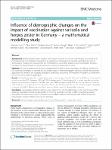Influence of demographic changes on the impact of vaccination against varicella and herpes zoster in Germany – a mathematical modelling study
Horn, Johannes
Damm, Oliver
Greiner, Wolfgang
Hengel, Hartmut
Kretzschmar, Mirjam E.
Siedler, Anette
Ultsch, Bernhard
Weidemann, Felix
Wichmann, Ole
Karch, André
Mikolajczyk, Rafael T.
Background: Epidemiological studies suggest that reduced exposure to varicella might lead to an increased risk for herpes zoster (HZ). Reduction of exposure to varicella is a consequence of varicella vaccination but also of demographic changes. We analyzed how the combination of vaccination programs and demographic dynamics will affect the epidemiology of varicella and HZ in Germany over the next 50 years. Methods: We used a deterministic dynamic compartmental model to assess the impact of different varicella and HZ vaccination strategies on varicella and HZ epidemiology in three demographic scenarios, namely the projected population for Germany, the projected population additionally accounting for increased immigration as observed in 2015/2016, and a stationary population. Results: Projected demographic changes alone result in an increase of annual HZ cases by 18.3% and a decrease of varicella cases by 45.7% between 1990 and 2060. Independently of the demographic scenario, varicella vaccination reduces the cumulative number of varicella cases until 2060 by approximately 70%, but also increases HZ cases by 10%. Unlike the currently licensed live attenuated HZ vaccine, the new subunit vaccine candidate might completely counteract this effect. Relative vaccine effects were consistent across all demographic scenarios. Conclusion: Demographic dynamics will be a major determinant of HZ epidemiology in the next 50 years. While stationary population models are appropriate for assessing vaccination impact, models incorporating realistic population structures allow a direct comparison to surveillance data and can thus provide additional input for immunization decision-making and resource planning.
Dateien zu dieser Publikation
Keine Lizenzangabe

